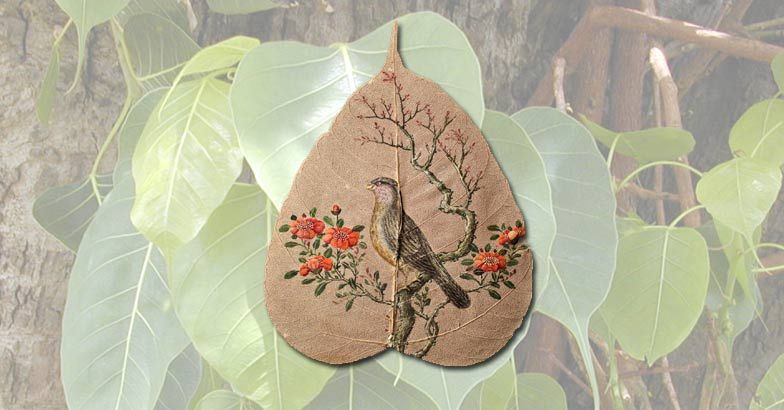The peepal tree has been associated with Indian sacred traditions and art, since time immemorial. A seal discovered at the ancient city of Mohenjodaro depicts the tree being worshipped. It was looked upon as a divinity. Mohenjodaro belongs to the Indus Valley civilization, the antiquity of which goes as far as 3000-1700 BC. According to Buddhist belief, Buddha gained enlightenment while meditating under this tree. Hence it has been known as the Bodhi tree.
Its heart-shaped leaves have long, tapering tips. This slender fan-shaped leaf lends itself to the beautiful and ancient art of leaf painting. At the same time it calls for a lot of patience and creativity on the part of the artist. This delicate art form is believed to have originated in Kerala. The leaves were also used for writing before the invention of paper. They were dried before being used for both painting and writing. Peepal leaf painting is a treasured part of the Indian heritage.
Procedure of leaf painting The technique of leaf painting involves a special procedure. Firstly the green leaf is immersed in a bowl of water for about 8-15 hours and then washed carefully under a tap till the outer surface is removed to expose the veins. Another method is to keep the leaves soaked in a bowl of water for a much longer period, say for about 15 days to a month. But the leaves have to be checked every few days as this prolonged soaking causes a film to form over the leaves. This layer needs to be removed. The water too has to be changed.
The outer surface of the leaves ultimately disappears leaving behind an offwhite skeleton. This bony structure should next be dried in the sunlight. The veined appearance of the skeleton leaf not only makes it attractive but also enables the leaf to preserve itself.
Once the leaf is dry, it is ready for the painting. It would be advisable to use a coloured sheet as a background for the leaf as it is highly delicate and even the slightest carelessness may lead to a rupture. The colour of the sheet could also enhance the beauty of the leaf painting.
Peepal leaf painting is usually done with oil colours. A gold-coloured border would greatly add to the beauty of the painting. A double coloured painting would also look unique. There is another way of presenting this art for those who are not confident of their ability to draw and paint. They could dip the leaf in water colours and dry it. It would look highly attractive.
There are various ways of enhancing the beauty of the peepal leaf painting. Tiny, glittering objects stuck on it could give it a stunning look. Or small clay idols fixed on the leaf would add a distinct look to it. If, during the process of painting, the work has to be left unattended, then it should be protected by a transparent sheet.
Themes of peepal leaf painting
The typical themes of the paintings are figures from Hindu mythology, animals and scenery. In some instances modern abstract art also provides a theme for this form of painting. Peepal leaf paintings are used to decorate wedding cards, and greeting cards, wall hangings, bookmarks etc.
(Powered by Executive Knowledge Lines)

















































 at a workshop by artist John Baby (left) at the art room of the Kochi-Muziris Biennale in December.jpg.image.160.84.jpg)






















.jpg.image.160.84.jpg)

.jpg.image.160.84.jpg)












































































































































 Peepal leaf painting is a treasured part of the Indian heritage.
Peepal leaf painting is a treasured part of the Indian heritage.
Disclaimer
The comments posted here/below/in the given space are not on behalf of Manorama. The person posting the comment will be in sole ownership of its responsibility. According to the central government's IT rules, obscene or offensive statement made against a person, religion, community or nation is a punishable offense, and legal action would be taken against people who indulge in such activities.